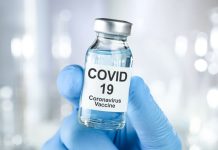NEW YORK, NY (July 10, 2020) — After only a few days caring for critically ill COVID-19 patients at the start of the outbreak in New York City, Aakriti Gupta, MD, realized that this was much more than a respiratory disease.
“I was on the front lines right from the beginning. I observed that patients were clotting a lot, they had high blood sugars even if they did not have diabetes, and many were experiencing injury to their hearts and kidneys,” says Gupta, one of the first Columbia cardiology fellows to be deployed to the COVID intensive care units at Columbia University Irving Medical Center.
In early March, there wasn’t much clinical guidance on the non-respiratory effects of COVID-19, so Gupta decided to coalesce findings from studies that were just beginning to appear in the literature with what the physicians were learning from experience.
Gupta, along with senior author Donald Landry, MD, PhD, chair of medicine at Columbia University Vagelos College of Physicians and Surgeons, organized senior co-authors, and Gupta, along with two other colleagues, Mahesh Madhavan, MD, a cardiology fellow at CUIMC, and Kartik Sehgal, MD, a hematology/oncology fellow at Beth Israel Deaconess Medical Center/Harvard Medical School, mobilized clinicians at Columbia, Harvard, Yale, and Mount Sinai Hospital, among other institutions, to review the latest findings on COVID-19’s effect on organ systems outside the lungs and provide clinical guidance for physicians.
Their review–the first extensive review of COVID-19’s effects on all affected organs outside the lungs–was published today in Nature Medicine.
“Physicians need to think of COVID-19 as a multisystem disease,” Gupta says. “There’s a lot of news about clotting but it’s also important to understand that a substantial proportion of these patients suffer kidney, heart, and brain damage, and physicians need to treat those conditions along with the respiratory disease.”
Blood Clots, Inflammation, and an Immune System in Overdrive
“In just the first few weeks of the pandemic, we were seeing a lot of thrombotic complications, more than what we would have anticipated from experience with other viral illnesses,” says Sehgal, “and they can have profound consequences on the patient.”
Scientists think these clotting complications may stem from the virus’s attack on cells that line the blood vessels. When the virus attacks blood vessel cells, inflammation increases, and blood begins to form clots, big and small. These blood clots can travel all over the body and wreak havoc on organs, perpetuating a vicious cycle of thromboinflammation.
To combat clotting and its damaging effects, clinicians at Columbia, many of whom are co-authors on this review, are conducting a randomized clinical trial to investigate the optimal dose and timing of anticoagulation drugs in critically ill patients with COVID-19.
The untempered inflammation can also overstimulate the immune system, and though doctors initially shied away from using steroids to globally suppress the immune system, a recent clinical trial has found that at least one steroid, dexamethasone, reduced deaths in ventilated patients by one-third. Randomized clinical trials are underway to target specific components of thromboinflammation and the immune system, such as interleukin-6 signaling.
“Scientists all over the world are working at an unprecedented rate towards understanding how this virus specifically hijacks the normally protective biological mechanisms. We hope that this would help in the development of more effective, precise, and safer treatments for COVID-19 in the near future,” says Sehgal.
Straight to the Heart
Clots can cause heart attacks, but the virus attacks the heart in other ways, one author says.
“The mechanism of heart damage is currently unclear, as the virus has not been frequently isolated from the heart tissue in autopsy cases,” says Gupta.
The heart muscle may be damaged by systemic inflammation and the accompanying cytokine release, a flood of immune cells that normally clears up infected cells but can spiral out of control in severe COVID-19 cases.
Despite the degree of heart damage, physicians were not able to utilize the diagnostic and therapeutic strategies, including heart biopsies and cardiac catheterizations, that they would normally use during the early stages of the pandemic given the need to protect personnel and patients from viral transmission. This has changed as the disease prevalence has gone down in New York CIty.
Kidney Failure
Another surprising finding was the high proportion of COVID-19 patients in the ICU with acute kidney damage.
The ACE2 receptor used by the virus to gain entry into the cells is found in high concentrations in the kidney and could likely be responsible for the renal damage. Studies in China reported renal complications, but in New York City, clinicians saw renal failure in up to 50% of patients in the ICU.
“About 5 to 10% of patients needed dialysis. That’s a very high number,” Gupta says.
Data regarding long-term renal damage are currently lacking, but a significant proportion of patients will likely go on to require permanent dialysis.
“Future studies following patients who experienced complications during hospitalizations for COVID-19 will be crucial,” notes Madhavan.
Neurological Effects
Neurological symptoms, including headache, dizziness, fatigue, and loss of smell, may occur in about a third of patients.
More concerning, strokes caused by blood clots occur in up to 6% of severe cases and delirium in 8% to 9%.
“COVID-19 patients can be intubated for two to three weeks; a quarter require ventilators for 30 or more days,” Gupta says.
“These are very prolonged intubations, and patients need a lot of sedation. ‘ICU delirium’ was a well known condition before COVID, and the hallucinations may be less an effect of the virus and more an effect of the prolonged sedation.”
“This virus is unusual and it’s hard not to take a step back and not be impressed by how many manifestations it has on the human body,” says Madhavan.
“Despite subspecialty training as internists, it’s our job to keep all organ systems in mind when caring for the patients in front of us. We hope that our review, observations, and recommendations can help other clinicians where cases are now surging.”
###
The paper is titled, “Extrapulmonary manifestations of COVID-19.”
Other authors are: Nandini Nair (Columbia), Shiwani Mahajan (Yale University School of Medicine, New Haven, CT), Tejasav S. Sehrawat (Mayo Clinic, Rochester, MN), Behnood Bikdeli (Columbia), Neha Ahluwalia (Icahn School of Medicine at Mount Sinai, New York, NY), John C. Ausiello (Columbia), Elaine Y. Wan (Columbia), Daniel E. Freedburg (Columbia), Ajay J. Kirtane (Columbia), Sahil A. Parikh (Columbia), Mathew S. Maurer (Columbia), Anna S. Nordvig (Columbia), Domenico Accili (Columbia), Joan M. Bathon (Columbia), Sumit Mohan (Columbia), Kenneth A. Bauer (Harvard Medical School, Boston, MA), Martin B. Leon (Columbia), Harlan M. Krumholz (Yale), Nir Uriel (Columbia), Mandeep R. Mehra (Harvard), Mitchell S.V. Elkind (Columbia), Gregg W. Stone (Columbia), Allan Schwartz (Columbia), David D. Ho (Columbia), and John P. Bilezikian (Columbia).
The authors received support from the National Institutes of Health (T32 HL007854, K08HL122526, R01HL152236, and R03HL146881, K23 DK111847, 5T32 NS007153, R01 AR050026, U01AR068043, R01-DK114893, R01-MD014161, and U01-DK116066) and the Department of Defense.
Financial disclosures are detailed in the paper.














